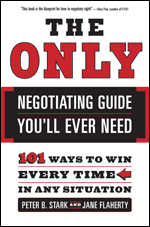Successful sales professionals have a positive vision of their success, know their subject matter and have a firm grasp of the negotiation process. In addition, they have a good understanding of people. Accomplished sales professionals know not only their own personal negotiating style, but also their buyer’s preferred style–and they use this knowledge to build a stronger relationship that will help accomplish their goals.
Most sales professionals undervalue the impact of behavioral styles on a negotiation. Many use the same approach in every negotiation and are surprised when they do not get consistent results. But an approach that works well for one buyer’s negotiating style can actually cause deadlock with a buyer who has a different style. Everyone is different and every negotiation is different. Sales professionals who acknowledge these differences and vary their approach to negotiations, practice what we call “The Ultimate Rule of Negotiation,” which is do unto others as they want to be done unto. In other words, successful sales professionals tailor their approach to the behavioral style and needs of their buyers.
Being able to identify a buyer’s preferred style and adapt your own style accordingly can be incredibly helpful in building productive relationships. With that concept in mind, let’s take a look at the characteristics that will help you identify your buyer’s preferred style, and consider some tips to building relationships that lead to win-win outcomes.
First, we will discuss Amiables. They are one of the easiest buyers to get an appointment with, and one of the most difficult buyers to complete the sale. Buyers who use the Amiable style have a strong need to feel recognized and valued in the negotiating partnership. Because they have a strong concern for relationships, they tend to focus more on feelings and less on facts. They will often begin a negotiation with social conversation that is unrelated to the negotiation. They are trusting, optimistic and generally committed to outcomes that benefit both parties.
To build rapport with your Amiable buyer, show genuine respect and care. Be sincere, and don’t discount personal feelings. Remain positive and solution oriented. Do not go head to head in a confrontational manner, which will most likely cause the Amiable to retreat and end the negotiation. Negotiate in a manner that builds trust and understand that for your Amiable buyer, negotiation is more than just business, it is personal. Never tell an Amiable, “Don’t take it personally.”
Another style that you may encounter when negotiating is the Driver. Drivers and Amiables are often noted to be at opposite ends of the behavioral style continuum. While Amiables are focused on the relationship with their counterpart, Drivers are results-oriented and focused primarily on the bottom line. Drivers have a strong concern for outcomes and when ruthlessly pursuing their goal, may become shark like. They tend to be impatient, have little need for detailed information, and want to move the negotiation to closure quickly. Drivers are self-confident, assertive, and when feeling cornered, may become aggressive in their tactics. While both the Amiable and the Driver have a need to achieve a positive outcome, for the Driver, winning is all important.
Preparation is critical when negotiating with a Driver. Know your bottom line. Be prepared and keep your interactions focused on business. This will help you remain assertive, direct, focused and succinct. We are fond of saying, “You can tell a Driver, but you can’t tell them much, so don’t try.” Instead, ask questions that allow Drivers to discover solutions and suggest acceptable alternatives. Understand that when negotiating with a Driver, however ruthless your counterpart becomes, it’s not personal, just business from the Driver’s perspective.
If your buyer appears cautious and reserved, he or she may be using the Analytical style. True Analyticals methodically explore all options, leaving no stone unturned in their quest for a fair and economical outcome. Analyticals have a strong need for facts and details, and won’t move forward unless they have had the opportunity to carefully analyze all available data. They tend to process information slowly and may be somewhat withdrawn or unemotional during the negotiation. They are organized, systematic and approach the negotiation methodically, one step at a time. To build rapport and gain respect from your Analytical buyer, do your homework before the negotiation begins. Make sure your research is complete and accurate. Keep your discussions factual and business related. Be honest, ethical and demonstrate ways in which outcomes will be advantageous in terms of money, time, or resources conserved. When you present information regarding your product or service to an analytical buyer, always present both the pros and cons. Finally, be patient and respect the Analytical’s need to process information methodically.
The last style we will discuss is the Blend. Blends are people who have no clear preference for one style, but use a combination of styles. Blends are personable, social and often have a sense of humor. They are flexible, creative and open to change. They are big picture thinkers and often have little need for details. To build rapport with Blends, take the time to begin the negotiation on a social note. Be creative in your solutions and focus on coming up with a number of viable options. When you reach agreement on details, make sure that the deal points are clarified and specific before finalizing the negotiation.
Next month, The Master Negotiator will take this topic one step further and walk you through the steps to help you discover your counterpart’s negotiation type. Until then, focus on gaining a deeper understanding of your own preference.
You may also like:



